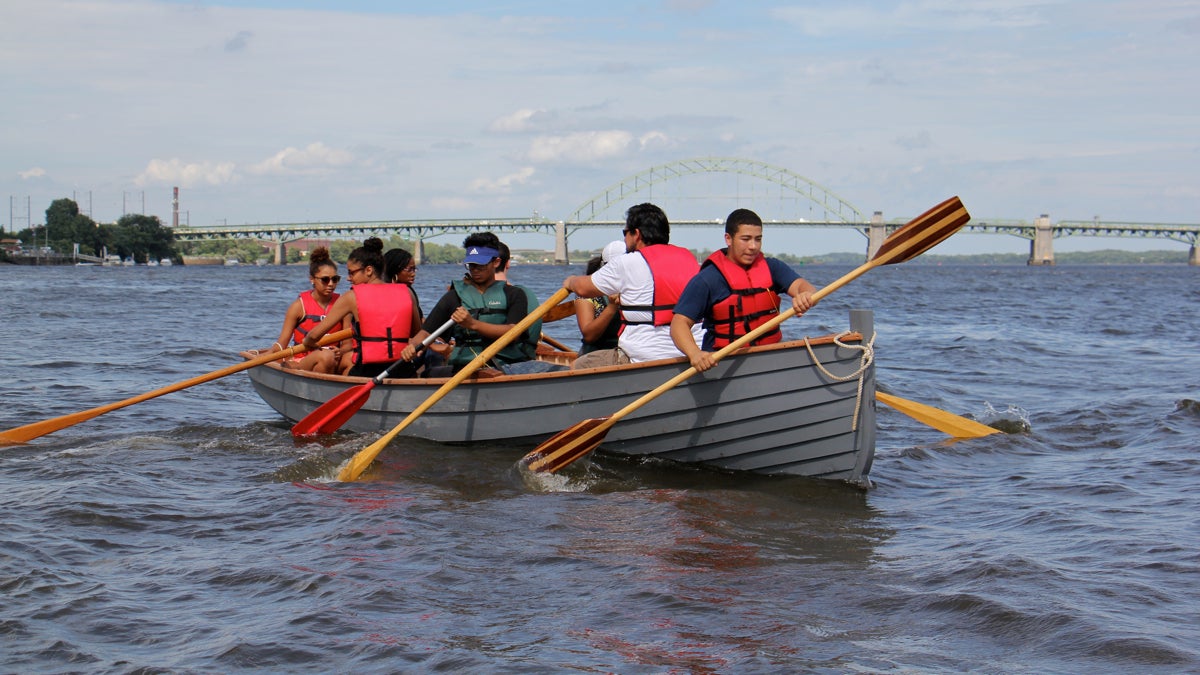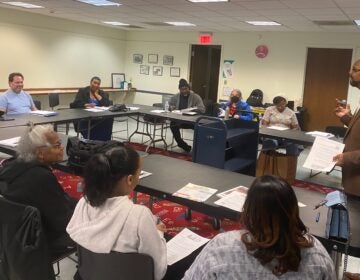WorkReady delivers summer jobs for Philly teens in an era of dwindling options

WorkReady students paddle on the Delaware River in a boat they built as part of the Wooden Boat Factory summer youth employment program. (Emma Lee/WHYY)
To find Thomas Doyle’s summer office you have to go a bit off the beaten path. Then you have to follow that trail off a dock and into the choppy waters of the Delaware River, where on Wednesday Doyle was bobbing along in a wooden rowboat.
“I didn’t think I was going to like it,” said Doyle, 17, as his oars cut into the current. “But I actually love it. It got me active. When I go to college I’m probably gonna join the row team.”
The rising junior’s job is to collect water samples and analyze them for Philadelphia Wooden Boat Factory, a nonprofit that teaches students marine science and boat building.
Now this sort of thing wouldn’t normally pay. But Doyle gets a check from WorkReady, a group that pays about 7,000 teens to do summer work at companies and organizations around Philadelphia. Most make minimum wage and work 20 hours a week for six weeks.
WorkReady, founded 14 years ago and overseen by the nonprofit Philadelphia Youth Network (PYN), pays its young workforce by raising millions from philanthropists and local government. This summer WorkReady raised about $14 million, according to PYN President and CEO Chekemma Fulmore-Townsend.
Beyond simply providing jobs, WorkReady is supposed to be a training wheels version of life in the adult workforce. Students have to apply for jobs and go on interviews. Their pay is deposited onto personal debit cards they can use to access their earings.
“If all we wanted young people to do was have money we would just give them a check, but the most important part is the learning,” said Fulmore-Townsend. “And we learn to work by working.”
A lot of kids are missing out on that lesson these days. The national youth unemployment rate is 15.6 percent, more than triple the overall mark. Meanwhile, the percentage of young people seeking work has been in freefall for years. Just 35.2 percent of Americans aged 16 to 19 are in the labor force, a figure that used to hover near 60 percent in the late 1970s. Historically the numbers have been even more dire in Philadelphia, where census data from the recession at one point showed youth unemployment at a staggering 45 percent.
Some of the changes in the youth labor market could be voluntary, with more teens preferring internships and volunteer opportunities to the old slog of flipping burgers. But Fulmore-Townsend believes it’s also a remnant of the economic recession, meaning many entry-level jobs are still clogged with more desirable and experienced adult employees.
“There’s a youth employment crisis in this country,” said Fulmore-Townsend. “It’s not as easy to go to the local super-market and get a job as a cashier.”
 RiverGuides students, (from left) Selena Espiet and Christopher Stewart, test Delaware River water for dissolved oxygen. (Emma Lee/WHYY)
RiverGuides students, (from left) Selena Espiet and Christopher Stewart, test Delaware River water for dissolved oxygen. (Emma Lee/WHYY)
Thomas Doyle knows that from experience. The Frankford High School student said he’d sought a number of jobs in the past, a job hunt that included the obligatory McDonald’s application. But none came through before WorkReady. His last summer was spent riding his bike with friends and “doing nothing.”
Josh Urquhart, 17, another WorkReady recipient at Philadelphia Wooden Boat Factory, said he played in a football league last summer. The summer before he was “in the house all day, eating candy, [and] being lazy.” Like Doyle, Urquhart prefers a busy, productive summer to idling at home.
“You come out. You’re here with your friends and it’s a bunch of fun,” he said.
Urquhart said he’s earned about a thousand dollars so far and squirreled almost all of it away. The same is largely true for Doyle. But he did allow himself one splurge: a pair of Jordan’s he spotted at the mall.
“I liked them, so I bought them,” he said.
WHYY is your source for fact-based, in-depth journalism and information. As a nonprofit organization, we rely on financial support from readers like you. Please give today.





